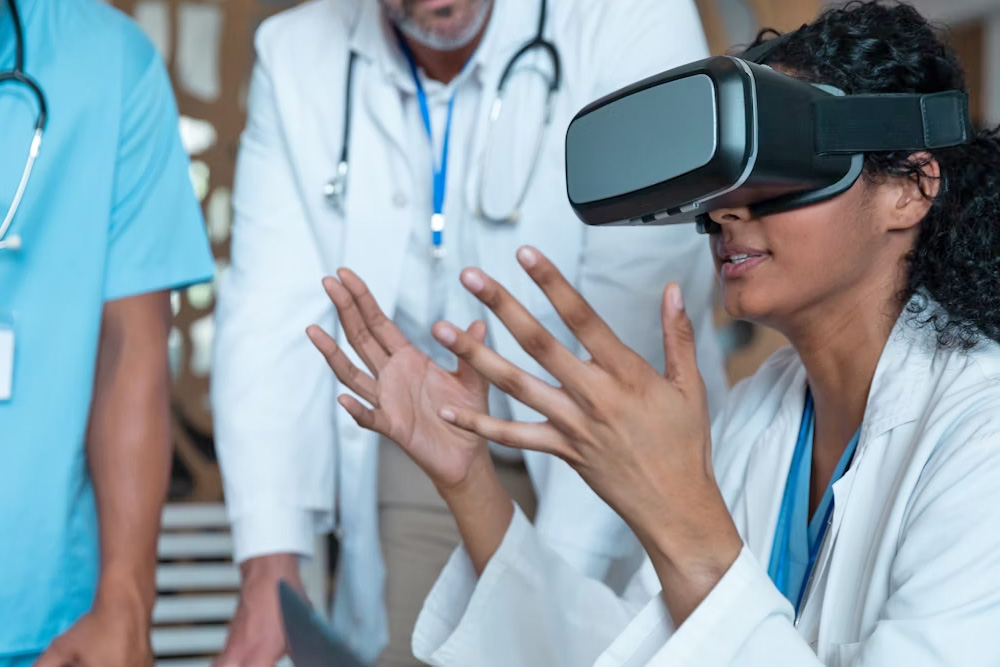Virtual Reality in Healthcare: Enhancing Medical Training & Patient Care

How Virtual Reality Is Transforming Healthcare
Virtual reality (VR) isn’t just for gamers anymore—it’s changing the way healthcare works. From how you train as a medical professional to how patients recover and manage pain, VR is pushing medicine into a new era of innovation.
Instead of relying only on textbooks, lectures, or cadavers, VR lets you step directly into a simulated operating room, walk through a patient’s experience, or even manage pain without medication. The result? Safer training, more confident providers, and better care for patients.
According to Precedence Research, the global VR in healthcare market is projected to reach $20.6 billion by 2030—and for good reason. Let’s break down how this technology is already making a difference.
VR in Healthcare: A New Frontier
At its core, VR is an interactive, computer-generated 3D environment that feels real. In healthcare, that means you can:
- Practice procedures without risking patient safety.
- Visualize anatomy in ways textbooks can’t match.
- Build empathy by experiencing conditions from a patient’s perspective.
But VR isn’t just for providers. Patients benefit too—using VR for pain management, rehabilitation, and even mental health therapy.
Medical Training: Why VR Is a Game-Changer
Let’s face it: mannequins and lectures can only take you so far. VR offers something different—immersive, hands-on training in realistic scenarios.
With VR simulations, you can:
- Repeat a procedure until it feels second nature.
- Sharpen decision-making skills in high-pressure situations.
- Customize your learning—whether you’re focusing on cardiology, orthopedics, or neurology.
In fact, a study published in the Journal of Medical Internet Research found that VR training improved surgical performance by 230% compared to traditional methods. That’s not just helpful—it’s revolutionary.
Building Empathy and Communication
Healthcare isn’t just about technical skill—it’s about people. VR helps you step into a patient’s world. Imagine experiencing life with Parkinson’s or Alzheimer’s in a simulation. Suddenly, you understand not just the symptoms but the daily struggles.
You can also practice tough conversations—like delivering bad news—in a safe, controlled space. These VR experiences help you build the kind of empathy and communication skills that set great providers apart.
VR for Surgeons: Precision Without Risk
For surgeons, VR training is like having a rehearsal before the big performance. You can practice brain surgery or complex cardiac procedures in a lifelike environment—without any risk to a patient.
Not only does this build confidence, but it also helps you master new techniques faster. One study from Harvard Business Review found that surgeons who trained with VR were 29% faster and made 6 times fewer errors than those who didn’t.
Patient Care and Rehabilitation
VR isn’t just helping doctors—it’s helping patients directly.
- Pain Management: Instead of relying on opioids, VR can distract patients with calming environments like beaches or forests. Research shows VR reduces pain perception by up to 24%.
- Rehabilitation: Stroke patients, for example, can use VR exercises to retrain their brains and regain motor function in a safe, motivating way.
- Mental Health: Through VR exposure therapy, patients with PTSD, phobias, or anxiety can gradually face their fears in a controlled setting.
It’s therapy that’s not only effective—but also engaging.
When VR Meets Other Tech
The real magic happens when VR is combined with other healthcare technologies. For example:
- AI can personalize your training sessions, analyzing your performance and giving tailored feedback.
- Voice recognition tools like Dragon Medical One let you document your VR sessions or patient notes instantly—freeing you from hours of paperwork.
That combination of immersive training and smart automation creates a healthcare environment that’s both innovative and efficient.
The Future of VR in Healthcare
What’s next? Expect even more realism: haptic feedback that lets you feel tissues during surgery, more affordable headsets, and wider adoption in hospitals and medical schools.
As this technology scales, you’ll see VR become an everyday tool for training, patient care, and therapy—not just a futuristic experiment.
Final Thoughts
Virtual reality is no longer a “nice-to-have” in healthcare—it’s becoming essential. Whether you’re learning how to perform surgery, building empathy for your patients, or exploring new therapies, VR helps you provide safer, smarter, and more compassionate care.
The future of healthcare looks both high-tech and human-centered.
